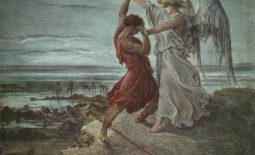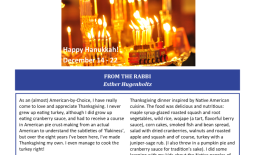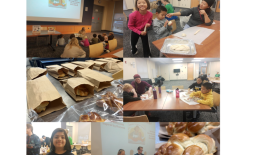With the Sea at Your Back and the Wilderness Ahead
Sermon Last Days of Pesach 2023
My husband likes to teach that the Seder plate is a time machine: not only is the plate itself round like a clock, but the items placed upon it represent the driving narrative of the Exodus and the timeline it unfolds on. From the time of ‘karpas’ (greens) of Israelite fecundity which threatened the Pharaoh ‘who did not know Joseph’ to the redemptive ‘zeroa’ (shank bone) that led the Israelites out, the thrust of history is undeniable.
More than many of our other festivals, Pesach loves playing with our notions of time. As we imagine ourselves as the generation who exited Egypt, the timeline of redemption collapses; we experience past, present and future at once. This is symbolized at the Seder by Miriam’s cup hearkening to the past and Elijah’s cup yearning for the future.
Lest we think these are mere philosophical abstractions, we catch hints of Pesach’s obsession with time in our Torah readings too, with surprisingly poignant effect. The fact that the following verses may strike us as relatively obscure only enhances the wisdom locked within them.
Traditionally, we read the following reading from Exodus on the 7th day of Passover. It recounts the splitting of the Sea of Reeds, the Egyptians giving chase and the Israelites passing through to safety and redemption. It is a spectacular, action-packed text and yet, there is an oft-overlooked verse that calls out to us ‘darsheinu’, ‘interpret me’!
‘Vayikach Moshe et atzmot Yosef imo’ – ‘and Moses took the bones of Joseph with him.’
The context is that Joseph had exacted an oath from his progeny committing them to carrying out his ossuary. It seems an odd passage, an obligatory reminder to an ancient vow, wedged in between the high drama of ‘k’riyat yam suf’, the splitting of the sea. Let’s put a pin in this passage for now.
Another unexpected passage comes up in the 8th day Torah reading from the Book of Deuteronomy; and it’s the first verse we read:
‘Kol habachor asher yivaled b’virkecha uv’tzon’cha hazachar takdish l’Adonai…’
‘You shall consecrate to your God all male firstlings that are born in your herd and in your flock…’
The context here is of course the parallelism the Torah creates between Pharaoh casting the Hebrew baby boys into the Nile and the ‘makkot bechorot’, the death of the first born as exacted as the final plague in retaliation for Pharaoh’s crimes and hardened heart. All first born are meant to be consecrated; not just livestock, but once upon a time Israelite males who for a time would enter Priestly service. (This was eventually replaced by the hereditary Priesthood).
What do both these verses have in common?
Both are fulfilling the Janus-like paradox of both glancing back at the past and facing the future. By any other name, we might call this ‘continuity’: Joseph, through his final wishes, guarantees continuity that despite the disruptions of slavery, his bones return to Canaan and his memory lives on. Likewise, the Torah’s command to consecrate firstlings is a reference to that final, fateful night of the plagues. Through commemorating that trauma, future generations find continuous sanctification. The past and future live on throughout the generations spanning the Jewish people; from the days of the Patriarchs to the tidings of the Messianic era.
Over the Passover holiday, I’ve been doing some reading to deepen my understanding of the temporal symbolism of Pesach. In his series of essays and commentaries on the Haggadah called ‘Redemption, Then and Now’, Orthodox Rabbi Benjamin Blech builds the interpretative arc of history through what he calls ‘memory and destiny’.
He identifies five Pesach-themed Jewish virtues that has sustained the Jewish people throughout time: memory, optimism, faith, family and responsibility.
These are big words, of course, but they help us draw down abstractions into our lived experience. Last week, many of us got to enjoy sitting at our Seders, be it in family homes or at communal Seders, where we saw these values manifest themselves in tangible ways. The Seder plate as a time-traveling device epitomizes memory; both mythical (the Exodus) and experiential (memories of past Passovers, remembering of loved ones passed on at Yizkor; of life cycles, of human relationships). The optimism that Rabbi Blech references finds expression in the rowdy L’shanah ha’ba’ah birushalayim’ we sing at Nirtzah, the conclusion of the Seder. Pesach reminds us that hope springs eternal.
It is this optimism that shows up in Jewish commitments to tikkun olam, repairing our world. Faith (or emunah, ‘trustingness’) is the unspoken investment in our Jewish future; the belief that our Judaism is a blessing to all generations. Some of us may feel the Divine Presence move through our lives; others may not. But we are bound by a profound sense of destiny that is an undeniable characteristic of our Jewishness. Family seems self-evident although it is important to point out this: Jewish families come in many constellations, whether they the traditional format, interfaith, LGBTQ, blended or chosen.
Still, ‘mishpochah’, refers to the ties that bind our hearts together—these are the people in our kinship groups we love and care for and these ties can be bound by chance or choice.
And responsibility? That is the final one and with good cause: it is our responsibility to teach the Pesach story to our children; to help future generations fall in love with Judaism in new ways but also to reinvent ourselves; to dig into the wisdom of the past but not to lean on our assumptions of nostalgia. To invite new groups of people into the ever-expanding tent of Judaism with confidence and knowledge that this will strengthen our people. To take to heart, always, the message of the Exodus: radical empathy trumps intergenerational trauma; we are a people who believe in destiny rather than happenstance, and that we are divinely obligated to help each new generation exit Mitzrayim into a world that is a little more redeemed that what the last generation found it to be.
The bones of Joseph and the consecration of the firstlings are not just obscure textual references. They are gems hidden in the text that invite us to step into the time machine; to honor the past, embrace the future, and with songs of redemption on our lips, be eager to anticipate what is yet to come, with the sea at our back and the wilderness ahead.




